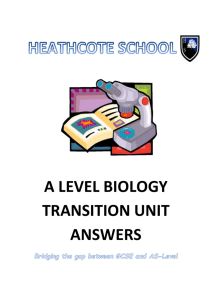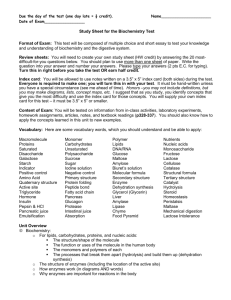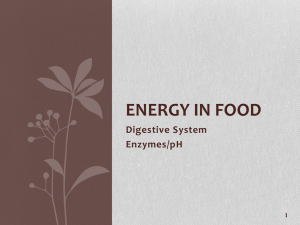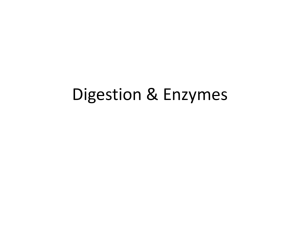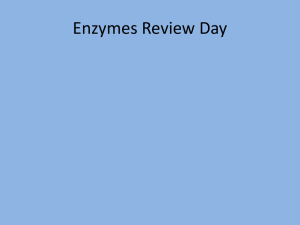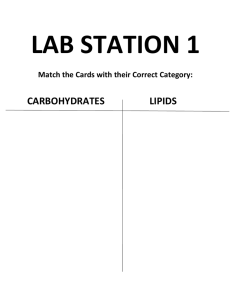biology transition pack answers
advertisement
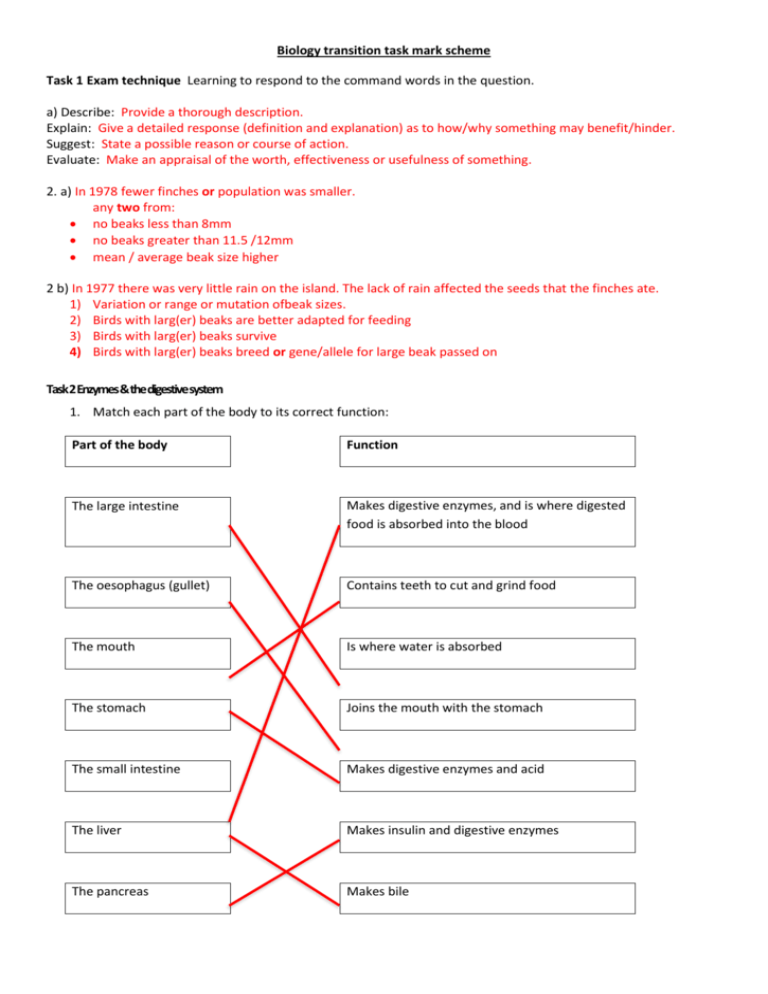
Biology transition task mark scheme
Task 1 Exam technique Learning to respond to the command words in the question.
a) Describe: Provide a thorough description.
Explain: Give a detailed response (definition and explanation) as to how/why something may benefit/hinder.
Suggest: State a possible reason or course of action.
Evaluate: Make an appraisal of the worth, effectiveness or usefulness of something.
2. a) In 1978 fewer finches or population was smaller.
any two from:
no beaks less than 8mm
no beaks greater than 11.5 /12mm
mean / average beak size higher
2 b) In 1977 there was very little rain on the island. The lack of rain affected the seeds that the finches ate.
1) Variation or range or mutation ofbeak sizes.
2) Birds with larg(er) beaks are better adapted for feeding
3) Birds with larg(er) beaks survive
4) Birds with larg(er) beaks breed or gene/allele for large beak passed on
Task2 Enzymes&thedigestivesystem
1. Match each part of the body to its correct function:
Part of the body
Function
The large intestine
Makes digestive enzymes, and is where digested
food is absorbed into the blood
The oesophagus (gullet)
Contains teeth to cut and grind food
The mouth
Is where water is absorbed
The stomach
Joins the mouth with the stomach
The small intestine
Makes digestive enzymes and acid
The liver
Makes insulin and digestive enzymes
The pancreas
Makes bile
1
2. What is the function of digestive enzymes?
Digestive enzymes break down food.
3. How does chewing food help to speed up digestion?
Chewing increases the surface area of food.
4. Completethefollowingtable:
Enzyme
Where is this enzyme
produced?
What food group does
the enzyme break
down?
What are the products
of the breakdown?
Carbohydrase
salivary glands,
pancreas, small
intestine
carbohydrates
sugars
(glucose/maltose)
Amylase
salivary glands,
pancreas, small
intestine
starch
maltose
Protease
stomach, pancreas,
small intestine
protein
amino acids
Lipase
Pancreas, small
intestine
lipids (fats)
fatty acids & glycerol
5. Which one of the following structures is not part of the alimentary canal?
(a) duodenum
(b) mouth
(c) liver
(d) stomach:
6. What name is given to the muscular contraction which moves food along the alimentary canal?
Peristalsis
7. Are the contents of the stomach (a) acid, (b) alkaline,{c) neutral?
Acid
8. What is the function of bile in digestion?
Emulsifies fats and provides optimum pH conditions for digestive enzymes.
9. How is the surface area of the small intestine increased?
Presence of villi and microvilli.
2
10. Describe how you would test for:
Fat
Emulsion test
Add ethanol and the water.
Starch
Add iodine solution.
Protein
Add biuret reagent.
Positive result: blue/black
Positive result: turns
purple/mauve.
Positive result: Cloudy white
precipitate is formed.
11. Name the structures labelled A to I.
A
Oesophagus
B
Stomach
C
Liver
D
Sphincter muscles
E
Bile duct
F
Gall bladder
G
Pancreatic duct
H
Duodenum
I each one:
Pancreas
12. Find out what the following mean and give one example for
a) Monosaccharide
The simplest sugar that cannot be further hydrolysed e.g. glucose,
fructose, galactose.
b) Disaccharide
Made up two monosaccharides joined by a glycosidic bond e.g. maltose,
sucrose, lactose.
c) Polysaccharide
Made up of many monosaccharides joined by glycosidic bonds e.g. cellulose,
starch.
3
Task 3: Factors affecting enzymes
1. What two things affect the activity of enzyme?
Temperature and pH
2. Enzymes in the human body have an optimum of 37oC. What does this mean?
This means they work most effectively at 37oC.
3. What is the minimum amount of energy required for a reaction to take place called?
Activation energy
4. How do enzymes speed up chemical reactions?
By providing an alternative pathway that has lower activation energy.
5. If an enzyme-controlled reaction normally takes place at 10ºC, in general terms how will the reaction be
affected by:
(a) a fall in temperature to 2°C
Enzyme activity will be reduced.
(b) a rise in temperature to 20°C.
Enzyme activity will be increase.
(c) a rise in temperature to 65°C?
Enzyme will denature and will stop working.
6. If an enzyme is denatured, why does it no longer work?
Active site becomes damaged so substrate can no longer fit inside.
7. The graph shows the rate of an enzyme
different levels of acidity or alkalinity (pH).
graph, what is the optimum pH for this
(a) pH 2
(c) pH 10
(b) pH 7
(d) none of these.
8. A protein-digesting enzyme when mixed with
solution would:
(a) have no action
(c) produce glucose
(b) produce amino acids (d) digest the starch?
reaction at
From the
enzyme?
starch
4
9. What are the 2 models for enzyme action?
Lock and key model
Induced fit model
10. In enzyme inhibition there are 2 inhibitors, find out what these are called
Competitive inhibitors
Non – competitive inhibitors
Task 4: Microscopes & Organelles
1. Eye piece
1. Label the microscope below:
4 & 5 Objective lenses
Can you figure out which one would be
the high/ low powered objective?
12.Arm
2. body tube
11. Fine adjustment knob
6. Stage
3 . revolving nose piece
8. Diaphragm
9. Base
14. Light
source
13. clip
7. Diaphragm
9. Base
10. Coarse adjustment knob
2. Find out the difference between light microscopes and electron microscopes.
Light microscopes
Can observe living things
Can observe in colour
Cheaper
Electron microscopes
Higher resolution
Higher magnification
Cannot observe living things
Cannot observe in colour
Expensive
5
Resolution:
The degree of detail that can be seen in an image.
Magnification :
Nucleolus :
Size of the image divided by the real size of the object.
Found in the nucleus, contains DNA.
Golgi apparatus : A stack of curved membranes that package and process proteins.
Lysosome :
Tiny bags of digestive enzymes surrounded by a single membrane.
Ribosome :
Tiny organelles that synthesise proteins.
Rough endoplasmic reticulum:
Network of membranes that have ribosomes attached to them.
3. You must know the following units of measurement when working with microscopes. They are all in comparison
to a metre. Complete the table below.
Unit
Symbol
Equivalent in metres
kilometre
km
103
metre
m
1
millimetre
mm
10-3
micrometre
µm
10-6
nanometre
nm
10-9
4. Place a tick in the box to indicate where the organelle is found. Some organelles can be found in both plant and
animal cells.
Organelle
Cell Wall
Chloroplast
Cytoplasm
Endoplasmic reticulum
Golgi apparatus
Lysosome
Nucleolus
Nucleus
Plasma membrane
Ribosome
Vacuole
Mitochondria
Plant Cell
Animal Cell
√
√
√
√
√
√
√
√
√
√
√
√
√
√
√
√
√
√
√
√
√
√
6
5.
Cells are categorised as either prokaryotes or eukaryotes. Find out what this means and give 1 example for
each of these categories.
Prokaryote
Eukaryote
Prokaryotes are single celled organisms that do
not have a nucleus.
Eukaryotes contain membrane bound organelles
including a nucleus.
Examples include any bacterial cells.
Examples include any plant or animal cells.
6. The diagram shows an animal cell
a) Name each labelled part and give its function
A Name Cytoplasm Function Where chemical reactins take place/carries or holds
organelles/contains water/presses out on the membrane
B Name Membrane Function Controls what enters and leaves the cell/ allows movement in and out
of the cell/holds the cel
C Name Nucleus Function Contains the genetic material.______________________________
7
Task 5: Movement across membranes
1. Placethe followingfeaturesinthecorrect partoftheVennDiagramusingtheletters given.
A Involveswater only
A
C
B Requires energy F
A
A
D
C Ispassive
D Movement ofparticles
B
E Howminerals
getintoroothair cells
E
G
A
A
F Hightolowconcentration
2. Whydoesactivetransport requireenergy?
G Againstaconcentrationgradient
Particlesaremovedagainstthe concentrationgradient.
3. Whatisthisenergyintheformof?
ATP
4. a. What is osmosis?
Movement of water.
From a high concentration of water to a low concentration of water.
Across a partially permeable membrane.
5. What will happen to the water level in the capillary tube during the investigation? Explain why this happens
It will rise, because the concentration of water outside is greater than
the concentration inside.
6. Describe two examples where osmosis is used in living things
Plants- take in water via osmosis; this creates turgor pressure keeping the plant upright /
Absorption of water in the colon/ Absorption of water via the kidney.
8
Task 6: Gas exchange
1. Where does gas exchange take place?
Between the alveoli and the blood capillaries
2. Describe how the lungs are adapted for gas exchange
Large surface area due to alveoli, moist lining, thin, copious blood supply.
3. Label the parts of the lung in the diagram below:
Trachea
Bronchus
Bronchioles
Alveoli
4. Describe the process of breathing in (inspiration)
External muscles contract, internal muscles relax.
Ribs move upwards and outwards.
The diaphragm contracts and flattens.
Volume in thorax increases.
Pressure in lungs decreases.
Air is forced into lungs.
5. Smoking causes emphysema, what is emphysema?
This is when the elastin in the lungs has been permanently stretched.
The lungs are no longer able to force out all the air from the alveoli.
6. Tuberculosis is caused by two species of bacteria. Find out the name for both these bacteria
Mycobacterium tuberculosis and Mycobacterium bovis.
7. Pulmonary ventilation is the total volume of air that is moved into the lungs in one minute. Find out the
equation for pulmonary ventilation.
Pulmonary ventilation = tidal volume x ventilation rate
9
8. The diagram below shows a vertical section of a leaf. Name labelled structures
U Waxy cuticle
P Upper epidermis
V Palisade
mesophyll
W Air spaces
Q Xylem
R Phloem
S Spongy mesophyll
F Guard cells
T Lower epidermis
Y Guard cell
X Stomata
9. Where doesgasexchangetake place ina leaf? Inthe spongymesophyll.
10. Whatisthe roleofthestomata ingas exchange. Allowscarbondioxideandoxygento diffuse intotheleaf.
Task7:Theheart
1. Label the diagramandcompletethe gapfillexercise below.
The Aorta takes blood to the body.
The Pulmonary Artery
takes blood to the lungs.
Pulmonary Vein
Vena
Cava
Left Atrium
Right
Right= Tricuspid &
Atrium
Left= bicuspid AV valves
Left
Right
Ventricle
Ventricle
10
2. Complete the passage below:
The heart is made out of cardiac muscle. It is a double pump that squeezes the blood around the body and to the
lungs. The right side pumps blood to the lungs to pick up oxygenated. The left side pumps blood around the rest of
the body.
3. Findoutanothertermthat is usedfora heart attack Myocardial infarction
4. Whichsideofthe heartisthickerandwhy?
Leftside,because it pumpsbloodtothe restofthe body.
5. Namethearterythatonly suppliesthe heartmuscle? CoronaryArtery
6. Name3 bloodvessels Artery,Vein,Capillary
7. Whichbloodvesselcontainsvalves?
8. Whatisthe functionofvalves?
Veins
Topreventthe backflowof blood.
9. Whatcauses heart disease? Buildupofafattymaterialcalledatheroma aroundtheinsideofthecoronaryarteries.
Task8:Causes ofdisease&immunity
1. Whatarethethreemaintypesofmicroorganisms? Bacteria,virus& fungus
2. Whatisa pathogen? Adiseasecausingmicroorganism.
3. Definethetermantigen Aproteinfoundonpathogensthatcausesyour whitebloodcellstoproduceantibodies.
4. List3thingsthatwhite bloodcellsdo White bloodcallsengulfpathogens, produceantibodies,andproduce antitoxins.
5. Whatisthe difference betweenanantibioticandanantibody?
Antibiotics areprescibeddrugsthat curebacterialdiseases. Antibodiesareproducedby the white bloodcellsto helpfightagainst bacteria.
6. Whatisfoundinavaccination? Adead/weakenedversionofthe pathogen.
7. Matchthedescriptiononthe leftwiththetermontheright bywritingthe correctletter ineachspace.
J=1, h=2, d=3, b=4, I=5, a=6, f=7, c=8, e=9, g=10
8. Findoutwhatcausescholeraanddescribethe symptomsofthisdiseases. CausedbythebacteriaVibrio cholerae. Symptoms include:
diarrhoea& dehydration.
11
9. Oralrehydrationtherapyisusedtotreatcholera. Findoutwhatthisrehydrationsolutioncontains.
water,sodium,glucose,potassium,andotherelectrolytes.
Oral rehydrationsolutioncontains
10. Whatisthe nameofthechemicalfoundincigarettesthatcausescancer? Carcinogens
11. Diseasecausingmicroorganismsgainentryintothe bodyviaoneofits interfaceswiththeenvironmentsuchastheskin. Name2other
examplesof interfacesthroughwhichmicrooganismsmaygainentry intothe body.
Digestive system and respiratory system.
12. How do pathogenscause disease? Bacteriareleasetoxins andvirusesdamagecells
.
